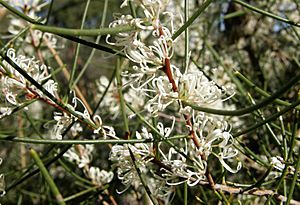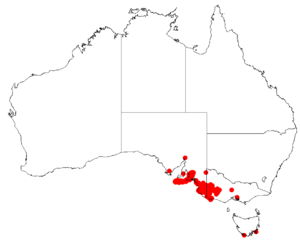Hakea rostrata facts for kids
Quick facts for kids Hakea rostrata |
|
|---|---|
 |
|
| Scientific classification | |
| Genus: |
Hakea
|
| Species: |
rostrata
|
 |
|
| Where the Beaked Hakea grows in Australia | |
The Hakea rostrata, also known as the beaked hakea, is a beautiful flowering plant. It belongs to the Proteaceae plant family. You can find it growing naturally in South Australia and Victoria.
Contents
What the Beaked Hakea Looks Like
The beaked hakea is a spreading shrub. It usually grows between 1 and 4 meters tall. Its young branches and leaves have tiny hairs. These hairs lie flat against the plant.
Leaves and Flowers
The leaves of the beaked hakea point upwards. They are long and thin, like a cylinder. They measure from 2 to 15 centimeters long. They are very narrow, less than 2 millimeters wide. These leaves do not have grooves.
The plant produces small groups of 1 to 10 flowers. These flowers grow on a small, knob-like stem. Each flower has a stalk that is about 2.5 to 6.5 millimeters long. This stalk is covered in many tiny hairs. The flower's outer parts, called the perianth, are 3.5 to 5.5 millimeters long. They are hairy near the bottom. The part of the flower that receives pollen, called the pistil, is 7.8 to 11.5 millimeters long. It has a special slanted disc that helps with pollen transfer.
Fruits and Seeds
The fruit of the beaked hakea is quite unique. It grows almost at a right angle to its stalk. The fruit has a curved, S-like shape. It is about 2.2 to 4.5 centimeters long and 1.8 to 3.2 centimeters wide. The surface of the fruit is rough and wrinkled. Sometimes, it has small black bumps.
A distinctive feature is its "beak." This beak is narrow and curves backwards. It is 7 to 14 millimeters long. It lies flat against the front side of the fruit. The fruit also has small, hard-to-see "horns." Inside the fruit, the seed does not fill the entire space. The seed itself is black with a lighter tip. In Victoria, the beaked hakea flowers from July to November.
Where it Grows
In Victoria, you can find the beaked hakea in different types of heathlands. It also grows in heathy woodlands. It prefers sandy soils. These areas are mostly in the western and south-western parts of the state.
How to Tell it Apart from Similar Plants
Sometimes, the beaked hakea grows near another plant called Hakea rugosa. You can tell them apart by a few key differences:
- The beaked hakea has curved leaves, while Hakea rugosa has straight leaves.
- The beaked hakea's pistil (the part that receives pollen) is curved, not straight.
- The beaked hakea has a slanted disc for pollen transfer. Hakea rugosa has a cone shape instead.
- The fruits of the beaked hakea are larger than those of Hakea rugosa.
Naming the Beaked Hakea
The scientific name of a plant is very important. It helps scientists around the world know exactly which plant they are talking about.
Who Named It?
The famous botanist Ferdinand von Mueller first gave this plant a name in 1853. However, he did not officially publish his findings in the correct way. The name was then properly published by Carl Meissner in 1854. This means Carl Meissner's publication was the first official record of the name.
What Does the Name Mean?
The second part of the plant's scientific name, rostrata, comes from a Latin word. The Latin word is rostratum, which means "beaked." This name perfectly describes the unique beak-like shape of the plant's fruit.

